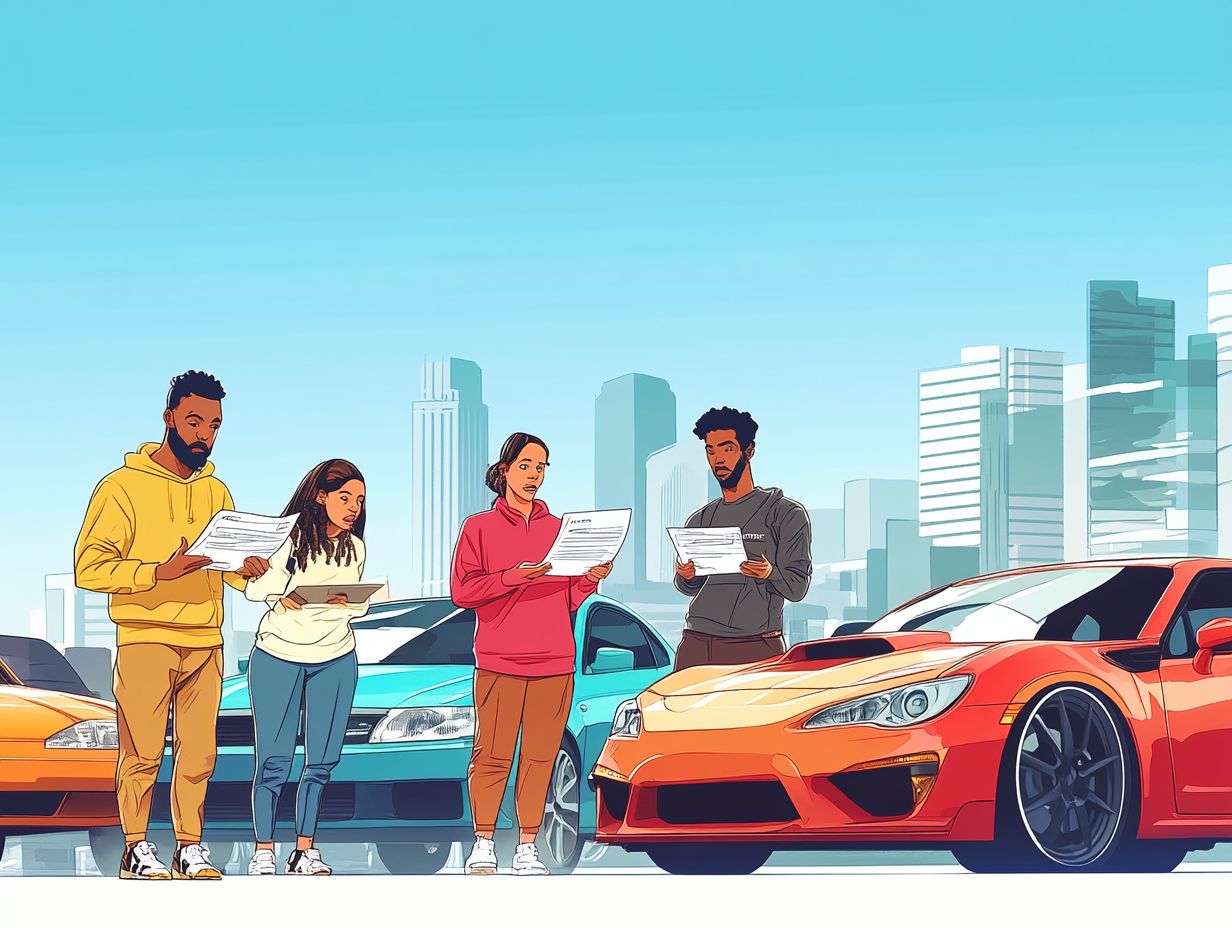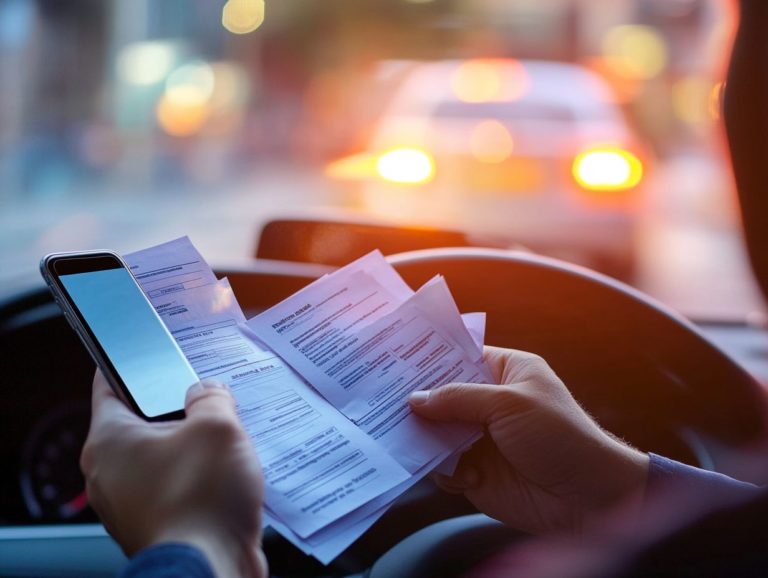5 Essential Coverages for High-Risk Drivers
Navigating the world of auto insurance can be particularly challenging for high-risk drivers like you. Whether it s due to a history of accidents, traffic violations, or other factors, securing the right coverage is essential to protect yourself and your finances.
Act now to find the best coverage tailored just for you! This article delves into five essential types of insurance that can offer the safety net you need. It also clarifies what defines a high-risk driver, the implications of this status, and provides practical tips to help you manage premiums and improve your driving record.
Contents
- Key Takeaways:
- 1. High-Risk Auto Insurance
- 2. Collision Coverage
- 3. Comprehensive Coverage
- 4. Personal Injury Protection (PIP)
- 5. Uninsured/Underinsured Motorist Coverage
- What Makes a Driver High-Risk?
- Frequently Asked Questions
- What are the 5 essential coverages for high-risk drivers?
- Why is liability insurance important for high-risk drivers?
- What does collision coverage do for high-risk drivers?
- What is comprehensive coverage and why do high-risk drivers need it?
- Why should high-risk drivers have uninsured/underinsured motorist coverage?
- What is personal injury protection and why is it important for high-risk drivers?
Key Takeaways:

- High-risk drivers need specialized insurance coverage to protect themselves and others on the road.
- Collision and comprehensive coverage are essential for high-risk drivers to cover damages to their own vehicles.
- Personal injury protection and uninsured/underinsured motorist coverage provide crucial financial protection for high-risk drivers in case of accidents.
1. High-Risk Auto Insurance
High-risk auto insurance is designed specifically for drivers with poor driving records, whether that includes traffic violations, poor credit histories, or a string of accidents. If you’re considered high-risk by insurers like USAA and Nationwide, you must find the right coverage options that not only protect you from financial losses but also comply with your state laws. To help with this, consider these 7 tips to find affordable insurance for high-risk drivers.
These policies differ from standard auto insurance because they account for a heightened likelihood of claims, resulting in higher premiums. As a high-risk driver, you’re likely contending with the dual challenge of escalating costs and fewer choices in the marketplace. That’s why it’s crucial to understand the best low-cost insurance policies for high-risk drivers that can help you navigate this situation and grasp the rating factors that affect your premiums.
The level of customer service can vary widely among insurers, which can significantly impact your claims experience. Therefore, it s vital for you to engage in thorough research, looking beyond just the price tag. Make sure to select a policy that delivers solid benefits, competitive rates, and responsive support tailored to your unique circumstances.
2. Collision Coverage
Collision coverage is an essential part of your auto insurance, especially if you find yourself categorized as a high-risk driver. It allows you to recover costs from vehicle damage due to accidents, offering you crucial financial support during challenging times.
This type of coverage not only shields you from significant out-of-pocket expenses but also ensures you can drive with peace of mind. If you’ve faced a history of accidents or traffic violations, having collision coverage becomes even more vital, as it lessens the financial blow of unexpected events.
Understanding the relationship between this coverage and your overall premium costs is key. While it may bump up your premiums initially, it often leads to long-term savings, particularly when considering benefits like accident forgiveness and efficient collision repair services. These elements can greatly impact your financial well-being and provide you with reassurance on the road.
3. Comprehensive Coverage
Comprehensive coverage offers high-risk drivers protection against a range of non-collision incidents, including theft, vandalism, or natural disasters. To ensure you get the best deal, consider these 5 ways to compare insurance for high-risk drivers, safeguarding you from unexpected financial losses due to vehicle damage.
This type of insurance is particularly advantageous for those living in areas susceptible to severe weather or higher crime rates. Not only does it provide peace of mind, but it also complements your collision coverage, which takes care of damages from accidents.
Together, these insurance options create a robust safety net, ensuring every angle is covered. Regarding filing claims for comprehensive damages, understanding the claims process is essential; it ensures you receive prompt and adequate compensation for your losses.
Being familiar with the details of your policy can significantly simplify the often daunting task of navigating paperwork and securing the financial relief you need.
4. Personal Injury Protection (PIP)

Personal Injury Protection (PIP) is a crucial coverage option for high-risk drivers like you. It provides medical expense coverage regardless of fault, ensuring that you and your passengers receive the necessary care after an accident. This alleviates potential financial burdens.
In states where certain levels of PIP are legally required, this coverage becomes even more beneficial. It plays a vital role in managing the often steep costs associated with medical treatments and rehabilitation. As a high-risk driver, the expenses you could face after an accident can be significantly higher. Thus, PIP is a valuable coverage.
Understanding how PIP interacts with other auto insurance policies is essential. Liability coverage helps pay for damages you cause to others, while uninsured motorist coverage protects you if you’re hit by a driver without insurance. By integrating PIP into your overall insurance strategy, you protect your financial health and ensure that you’re prepared for any unforeseen circumstances on the road.
5. Uninsured/Underinsured Motorist Coverage
Uninsured/Underinsured Motorist Coverage is essential for high-risk drivers like you. It provides invaluable protection against financial loss when you’re in an accident with someone who lacks adequate insurance. This coverage not only keeps you legal but also gives you peace of mind on every drive.
Think of this type of coverage as your safety net. It covers medical expenses, vehicle repairs, and lost income if you’re in an accident caused by an underinsured or uninsured driver. Its importance can’t be overstated, especially for drivers like you who may already face higher insurance premiums.
The requirements for this coverage can vary significantly from state to state. Some make it a legal requirement, while others offer it as an optional add-on. Without this protection, you risk significant financial burdens, making you more susceptible to legal complications and debt should an unfortunate accident occur.
What Makes a Driver High-Risk?
You may find yourself classified as a high-risk driver due to several factors. A history of traffic violations, reckless driving, poor credit ratings, or frequent accidents can all contribute to this classification. Understanding your driving record is essential, as it affects your insurance rating and premium costs.
Various aspects contribute to this classification, including the nature and frequency of traffic offenses like speeding or DUI, which indicate a lack of responsibility behind the wheel. Poor driving habits also worsen your situation, such as aggressive acceleration or tailgating. Financial factors cannot be ignored; a poor credit history can drive up your insurance premiums.
Insurers often view high-risk drivers as more likely to file claims. Consequently, this results in limited coverage options and steep costs. Understanding ways to improve your insurance status is crucial for anyone labeled as high-risk, including you.
What Are the Consequences of Being a High-Risk Driver?
Being labeled a high-risk driver comes with serious ramifications. You may face soaring premium costs, limited coverage options, and increased scrutiny from insurance companies. This can lead to potential financial loss for those struggling to secure adequate insurance coverage.
Such a classification often arises from factors like a history of accidents, traffic violations, or even your age demographic. This makes the pathway to affordable insurance particularly daunting. As a result, you may encounter multiple obstacles that disrupt your daily commuting and complicate your financial planning.
The heightened perception of risk can deter insurers from providing competitive rates. This leaves you with fewer options and a significant financial burden. Consequently, these challenges can lead to increased stress and anxiety while driving, undermining your overall confidence and safety on the road.
How Can High-Risk Drivers Lower Their Insurance Premiums?

High-risk drivers can take several proactive steps to lower their insurance premiums. By improving your driving habits, enrolling in defensive driving courses, and seeking out policies that offer accident forgiveness, you demonstrate your commitment to safe driving.
You can also enroll in safe driving programs, which not only equip you with valuable skills but may also unlock attractive discounts on your coverage. Maintaining a clean driving record is vital; even minor infractions can lead to significant premium increases.
Working with a knowledgeable insurance agent can be incredibly advantageous. They can negotiate on your behalf and uncover competitive quotes tailored to your specific needs, ensuring you find the best possible rates while making informed decisions about your coverage.
What Are Some Other Coverages That High-Risk Drivers May Need?
Along with standard auto insurance policies, as a high-risk driver, you may find value in additional coverages like collision repair, uninsured motorist coverage (insurance that protects you if you’re in an accident with a driver who doesn’t have insurance), or optional perks such as new car replacement. For more information, check out these resources for high-risk drivers seeking insurance. These enhancements can significantly fortify your financial protection against unexpected events.
Take a moment to explore your unique circumstances and evaluate which coverage options align best with your needs. For example, comprehensive coverage can shield you from damage caused by natural disasters or vandalism, while roadside assistance can be a true lifesaver in emergencies.
Understanding the laws in your state is essential, as regulations can vary widely and may affect both the necessity and cost of certain coverages. By carefully assessing these factors, you can secure a policy that not only meets legal requirements but also offers you peace of mind when navigating challenging driving conditions.
What Should High-Risk Drivers Look for in an Insurance Company?
High-risk drivers should focus on several essential factors when choosing an insurance company, including exceptional customer service, a transparent claims process, and understanding liability coverage for high-risk drivers that offers a diverse range of options tailored to your specific needs.
Having a dedicated team available to assist with any inquiries can significantly elevate your overall experience, ensuring that you feel supported throughout your policy period.
Understanding the various coverage options is vital, as this knowledge enables you to customize your plan to fit your unique circumstances.
Investing time in comparing policy features and rates across multiple providers can reveal opportunities for better deals. This proactive approach not only helps you secure affordability but also guarantees that your chosen policy effectively addresses your distinctive risks and requirements.
How Can High-Risk Drivers Improve Their Driving Record?
High-risk drivers seeking to enhance their driving records should prioritize safe driving practices, attend driver safety courses, and remain vigilant about traffic rules. These steps will help reduce violations and elevate your overall insurance rating.
By embracing these strategies, you not only lower the likelihood of facing additional penalties but also foster a safer driving environment for yourself and others on the road. Enrolling in a defensive driving course offers invaluable insights into traffic dynamics, enabling you to make wiser decisions behind the wheel.
Regularly monitoring your driving habits through specialized apps can pinpoint areas needing improvement, allowing you to identify and rectify risky behaviors. Cultivating a routine of sticking to speed limits and steering clear of distractions like mobile phone usage greatly reduces the risk of accidents, ultimately protecting your insurance status and providing you with peace of mind.
Watch this video for more tips on improving your driving record!
Frequently Asked Questions

Here are some common questions high-risk drivers ask about their insurance.
What are the 5 essential coverages for high-risk drivers?
The 5 essential coverages for high-risk drivers include liability insurance, collision coverage, comprehensive coverage, uninsured/underinsured motorist coverage, and personal injury protection.
Don’t wait! Start improving your driving today to lower your insurance costs!
Why is liability insurance important for high-risk drivers?
Liability insurance protects against damages and injuries you may cause in an accident. For high-risk drivers, this coverage is essential to shield against lawsuits and hefty financial losses.
What does collision coverage do for high-risk drivers?
Collision coverage pays for damage to your vehicle after an accident, no matter who s at fault.
This coverage is crucial for high-risk drivers who might face more accidents.
What is comprehensive coverage and why do high-risk drivers need it?
Comprehensive coverage protects your vehicle from non-collision-related damages, like theft or natural disasters.
High-risk drivers should have this protection against unexpected events that could harm their vehicles, and following these tips for managing your high-risk driver insurance can be incredibly beneficial.
Why should high-risk drivers have uninsured/underinsured motorist coverage?
This coverage safeguards you if you re in an accident with someone who lacks insurance or enough insurance to cover costs.
It’s particularly important for high-risk drivers who may frequently encounter uninsured motorists.
What is personal injury protection and why is it important for high-risk drivers?
Personal injury protection (PIP) covers medical bills and lost wages for you and your passengers after an accident, regardless of fault.
This coverage is vital for high-risk drivers who face a greater chance of accidents and injuries.






